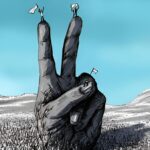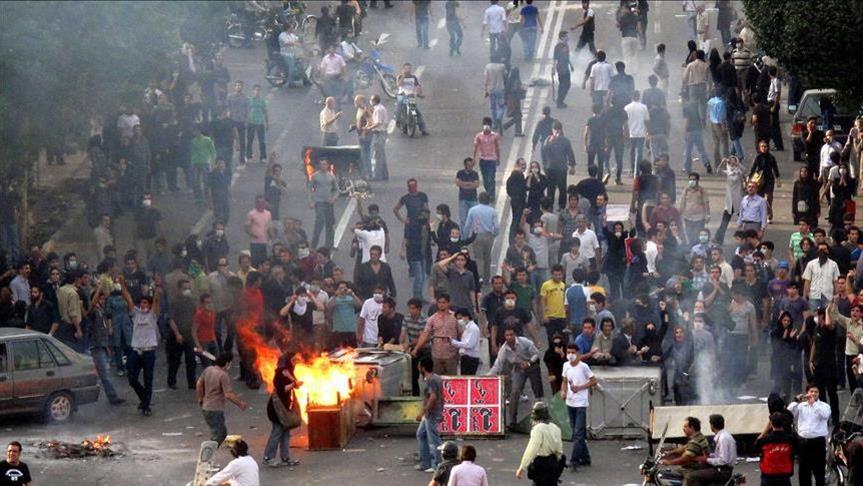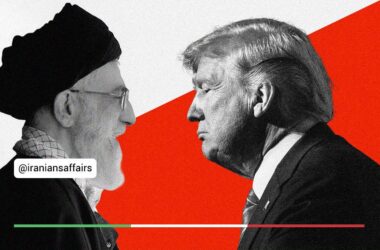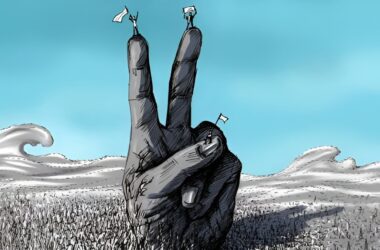The continuous and expanding multi-year trend of protests in Iran and popular uprisings in the streets have necessitated a new formulation of the political outlook in Iran. An essential point in this assessment is a focus on the growing revolutionary energy in Iranian society; in a way that, regardless of political currents, a significant societal transformation has occurred. Although since early 2018 when street riots began in Iran, there was no political manifestation or representation; however, this trend has expanded to the extent that now, no political movement inside or outside Iran can be examined without reference to these street developments. Iran witnesses the emergence of a societal power movement that hasn’t yet settled on a clear political platform; it exhibits significant radical energy and has the potential to disrupt the country’s balance of power.
A shrewd political perspective on this short historical trajectory should focus on recalibrating political relationships, emphasizing the pivotal power points and playing a role in the transition to a new era. Currently, this ideal political perspective is absent in the Western, particularly the US, policy towards Iran. While the political delusions of the leaders of the Islamic Republic have, from the outset of their rule over Iran, been against the US and the Western world order, being converted into the country’s foreign policy and still continuing based on those delusions; US policy towards this regime has had numerous ups and downs, and at critical times, has acted passively with optimistic and intelligent delusion. The latest peak of these unrealistic policies harks back to the initial and unsuccessful plan of the Biden administration to establish a step-by-step comprehensive agreement with the Iranian government, from the nuclear program to regional policies.
The supremacy of academic perspectives in the design of US policy toward Iran, which haven’t been tested in the arena of reality and have confused abstract intelligence with astuteness in understanding political power relations, has resulted in the continuous expansion of challenges arising from the actions of the Islamic Republic’s government towards the US for over four decades. Various policies of containment, pressure, deterrence, negotiations, and agreements have fluctuated in response to the Iranian government. This has led to a fragile, temporary, and episodic agreement, a situation that will likely lead to the emergence of even more acute regional and security crises in the short term.
Now, however, a unique opportunity has arisen for the US to design a political perspective that aligns with the developments of social forces in Iran, achieving multifaceted results from reforming the situation in the Middle East to reviving the horizon of US global leadership and re-integrating Iran into US-centric global policy. To properly understand this opportunity, one must consider the instability crisis in Iran, the fragile state of the regime both domestically and internationally, and the wave of new social power against the government. In a situation where the Iranian government, after the JCPOA agreement, was expanding its domestic authoritarian process and regional influence with increased confidence, new narratives in both the arena of US global politics and the emerging social force within the country have disrupted the entire scene.
At that time, the hardline stance of the Trump administration against the Iranian government, as it manifested through unprecedented expansion of sanctions and political and security pressures, influenced the internal perception towards the Iranian government. While the Iranian society’s expectations of the economic relief from the JCPOA were not met, the unprecedented confrontation of the U.S. government with Iran set a different level of expectations within the country. The Trump administration’s hardline stance cultivated a vision of the decline of the Iranian government in the minds of the Iranian society. This vision, combined with long-standing prior grievances and the emergence of new generations and perspectives within Iranian society (which have wholly detached from the political, social, cultural, and material mechanisms of the Islamic Republic era), paved the way for a potential revolution in Iran and the overthrow of the Islamic Republic.
The tangible conditions in present-day Iran have synchronized with popular narratives within the society, and the culmination of this mix is directed against the government, favoring a radical political revolution. It’s crucial to understand that the psychological impact of global policies against the Iranian regime at this specific historical juncture is incomparable to any other period in the regime’s history. The creation of favorable conditions for a significant political upheaval, like a revolution, results from a rare, astonishing combination and fortune. If managed with political astuteness, significant change becomes attainable. The chances of creating a victorious revolutionary mix in Iran are not far-fetched, provided the discrepancies in the Western, especially American, global policies and the crisis of the revolution’s political representation are resolved. These two challenges seem intertwined and also open doors to overcoming internal challenges, pushing the regime to its knees.
American skepticism about the political aspects of revolutionary conditions in Iran is often justified by the fact that the opposition is not cohesive, or there is no clear political agenda for regime change, leading to political inaction towards Iran’s internal conditions. This overlooks the root causes of Iran’s revolutionary circumstances, even though Trump’s confrontational policy against Iran was very effective in creating a mentality of the Islamic Republic’s decline within Iranian society. After the widespread and radical protests last year in Iran, the absence of that Western confrontational attitude against the ruling regime was one of the primary reasons for the political stalemate among government opponents. Media portrayal of the situation in Iran last autumn was mostly centered around a specific social trend focused on culture, while the most radical social forces in Iran were risking their lives on the streets for political change. U.S. policy towards the revolutionary conditions in Iran couldn’t synchronize with the developments of social power dynamics but rather became influenced by media narratives and its artificial actors.
The fact that the Iranian regime has established such a level of anti-American identity construction for itself that any aggressive confrontation by the U.S. government against this regime signals the bell of its threat and even its demise, has not yet been fully understood by the U.S. foreign policy apparatus. If global politics, led by the U.S., can convey this narrative to Iranian society, challenging the regime in power in Iran and aiding the rise of a nationalist political alternative with the social power in Iran, it will resolve the majority of the mental crisis of triumph in Iranian society and even among the wavering forces so far loyal to the regime. Success in showcasing power for an alternative political leadership in Iran, without the accompaniment of the U.S., will be complex and slow to come. This opportunity has become possible thanks to the regime’s vivid portrayal of enmity with the U.S. throughout its life and the mental wavering of its loyalists in the face of U.S. power.
If the U.S. government can, alongside its practical and mental portrayal of a hardline confrontation with the Iranian regime, support the regime’s opponents at both the security and political levels, it will have a threefold effect on the forces influencing the revolution in Iran. A credible political force, if recognized by U.S. policy, can convey this message to the people of Iran that we have obtained the antidote to the oppressive power governing the country (keep in mind that public sentiment in Iran is greatly influenced by the position of political power in the hierarchy of power – whether internal or external). The military and security forces serving the Islamic Republic regime, under psychological pressures facing the radical protesting majority, are mentally fragile. A picture of the alignment of nationalist political leaders in alliance with U.S. power sends them the message to set aside their doubts in favor of a new era and future power relations and to abandon the regime. The radical social power, when faced with a reassuring and supportive image that resolves their mental vacuum of defeat against repression, will more bravely and determinedly take to the streets and paralyze the regime.
The pivotal factor in the role of American policy during the revolution is a smart investment in powerful political forces. America, moving past its past autumn mistakes, where its foreign policy trajectory vis-a-vis Iran’s domestic developments was determined by fake and irrelevant Western media games (focused on Western progressive and leftist favored aspects), should center its approach on political relationships and power hierarchies with Iranian opponents. In this regard, focusing on the spectrums of social power inside Iran clearly identifies that leaders who represent Iran’s illustrious history (before the rule of the Islamic Republic regime) and have the capability to evoke a nationalistic fervor among Iranians, have the most alignment with the emerging social force in Iran.
If American policy can reach an agreement over a joint transition plan with these leaders, and push the necessary financial, technical, media, and political support towards these political forces, it would not only solve the representation issue of the revolution in Iran but also have the opportunity for constructive and early collaboration with the most likely leaders of the country in a democratic setting. Additionally, propelling the Iranian revolution along a nationalistic stability axis, while accompanying the internal revolutionary wave, stands the best chance to attract the support of internal military and security forces (which, due to various historical reasons, don’t relate to the Western progressive aspects narrated in the revolutionary conditions of last autumn in Iran; however, they become more unsettled and cooperative under the nationalistic revolutionary aspects). On the other hand, nationalist political alternatives in the course of the Iranian revolution can lead to extensive identity rifts among opponents and fuel ethnic conflicts in the sensitive and crisis-prone Middle East region. This can itself present a new horizon of insecurity, allow the Islamic Republic regime an escape from collapse in the face of the revolutionary flow, and give rise to a new wave of anti-Western radicalism in the region.

